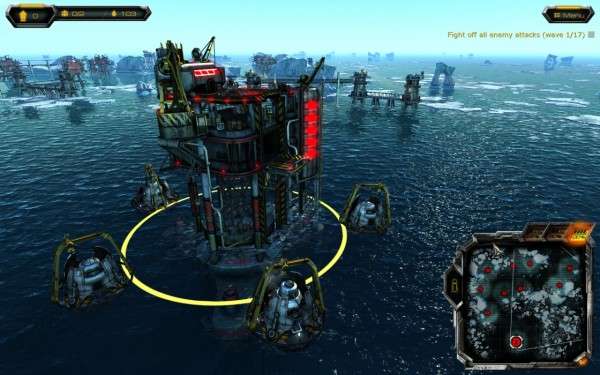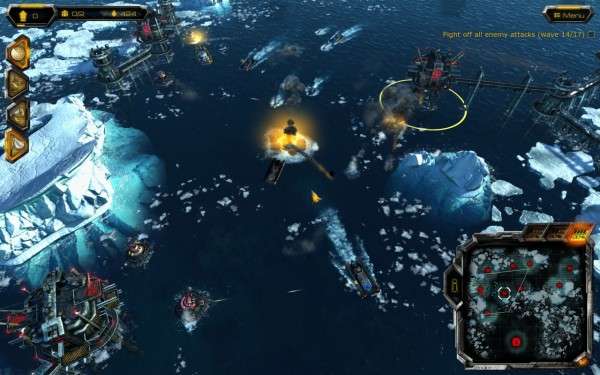
Oil Rush PC Review
It’s not the first time a graphics benchmark company has experimented in making a game with their own engine. Futuremark (the developers of the benchmark tool 3D Mark) did it a few years ago with Shattered Horizon. Now Unigine Corp (makers of the GPU benchmark Heaven DX11) is releasing a game that uses their Unigine Engine. Titled Oil Rush, this real-time strategy (RTS) game available on Windows, Linux or Mac, blends “the strategic challenge of a classic RTS with the sheer fun of Tower Defence.”
Set in a post-nuclear war world, the melted ice caps have raised the sea level dramatically, with most of the world covered in vast waves of ocean. Survivors have taken up the remaining dry land and formed factions, each one battling for the same substance – oil – that will help them become the dominate clan on the planet. Taking the retail version for a spin (which allows both Steam install and general Windows install) I was ready to learn all the complicated bits and bats associated with the genre. However, I was startled at how easy this game was to learn compared to other RTS games.

The reason behind this is because Oil Rush is different from your typical RTS game. You see, unlike normal RTS gameplay, you cannot control your units directly through commands. In more of a distinctive take on the RTS formula, units are instead attached to bases that are placed around the battle map, circling them to act as defence if attacked. These bases will be one of two types. The first one is oil pumps – these are vital to obtain because they give you your only source of income. Unit producing bases are the other type that will timely build and release units from their hangers. Interestingly, the type of buildings you own will determine what units build towards your army. So not only can you not control your army individually, you also cannot choose what units to build when you want. You can see where I am coming from when I say this isn’t a typical RTS.
You might think this limited control system in a RTS would be horrible, but it actually makes for an interesting twist. For one there is basically no micromanagement; instead, you need to keep an eye on your maximum unit count, oil income and where your units are placed on the map. The element of RTS in this game comes from the player consistently sending units to bases around the map in a “join the dots” fashion. Since you can’t directly control the units, they take a direct route to the base you point them to. If the base or oil pump is neutral, a bar with your army’s colour will begin to fill on the side of it; once filled, you take over the base and your units will begin to guard it. Taking over a occupied base requires you to remove every enemy threat before you can wipe their colour off and turn it into your own. It’s easy to keep an eye on your units scattered around the battlefield and who owns what area because of the mini-map on the bottom right of the screen. You’ll spend quite a lot of time looking and using the mini-map to move units around rather than clicking on the fancy looking version that’s on the main screen.

Since conflicts always takes place on water, you can expect the units to be an assortment of boats. Flying vehicles are also accessible so that you can attack from above. Units include armed jet skis, hammerhead boats, planes and helicopters. Everyone has an advantage. Planes can be used to scout areas and take over out of reach oil rigs that no one has captured yet. Jets skis are nippy little things that are great for rushing past defences, and the heavy boats can just pound ships with sheer power. You’ll never be able to choose the right amount of each unit you want, but the automatic building makes it helpful to start filling your unit count back up after an assault went bad.
If there’s one fault with this base to base control, it’s that you cannot force your units to move to another base if they have already set off for one. You never click on a unit; instead, when you highlight a base on the map, it will inform you with how many units are attached to it. If you right click on another base while having one highlighted, the game will send the units off on their journey. The only action you can take while they are in this state is recall them to the station they just left. It can be frustrating sometimes if you accidentally click the wrong base, and if someone begins attacking you’ll have a mighty high chance of losing that base to the enemy. You don’t have to send them all the units out though – you can select between 100%, 50% or 25% of the units stationed at a building to move to the next one. This helps a lot when you need to space out units to defend against multiple threats.

To protect against assaults, any base that builds units can be fortified with five turrets around it. This is one of the reasons why you need to stock up on oil. Turrets can also be upgraded to make them better at attacking and take more damage from fire. Different types of turrets defend against different units. Cannons are great for smashing into big bulky ships. Machine guns on other hand will pop down smaller boats. These defences are very important because you cannot construct turrets to guard oil rigs. Oil rigs need to be watched because an opposing unit can sneak in and steal it from right under your nose. Splitting units up so you have some left behind at the rigs is a nice way to slow down the process of losing it to the opposition army.
Oil is needed furthermore to use abilities that you unlock in a skill tree. Killing opposing forces will earn experience that will in turn change into points to put into the skill tree. There’s a range of abilities, such as buffing your turrets, debuffing enemies on certain structures and increase the speed of building turrets. Using the right one is vital to winning a battle. With the limited control you have over your army, you need every chance to turn a fight in your favour.

It might take a while to get used to this way of playing an RTS, but the campaign in Oil Rush does a good job at explaining everything and allowing you to adjust to the game’s mechanics. Once through the game’s 16 missions, you can jump straight into skirmish or multiplayer matches. Online has a selection of 15 maps. An interesting feature with the maps is that each one is themed around a style of play. One of the maps has one oil rig that both players must try to capture; the first to hit a target amount of oil salvaged wins. Another focuses on using air supremacy to turn the tide of the war in your favour. Oil Rush does a wonderful job at making them all interesting rather than sticking to the general formula that you are taught in the single player. Miserably, I have to report that it was really hard to find a multiplayer game, with me just having one game with a friend of mine to test it out. It’s a real shame because it was a lot of fun; these smaller game titles don’t seem to get the interest they rightly deserve.
Oil Rush looks fantastic. Unigine Corp has managed to show off what the Unigine engine can produce with its beautiful and detailed texture and water shaders. Environments are filled with small samples of history, such as buildings submerged after a ravaged flooding, jungles growing on small islands and ice cold oceans breezed in sleet – the artist knew how to make the engine work to his or her favour. If you can run it at maximum specifications, which aren’t all that demanding, then you’re in for a treat. Soundtrack is pretty good too with some fast upbeat industrial tracks, and some are quite catchy. Voice acting on the other hand is something that didn’t receive as much dedication as the graphics; it’s below par, and some characters just don’t seem to put in a effort at delivering lines with emotion.
I was genuinely surprised at how engrossing and fun Oil Rush was to play even though it’s light on the RTS elements. Some mechanics might be slightly frustrating because of the limitation of the control system, but the way the game is designed is a perfect candidate for people who are scared off by the complexity and deep learning curve customarily linked to appreciating the modern day RTS game. Oil Rush could have been an all graphics, no gameplay showcase for Unigine, but somehow they have managed to make a neat looking and refreshing RTS that makes for a great evening in front of the computer.
